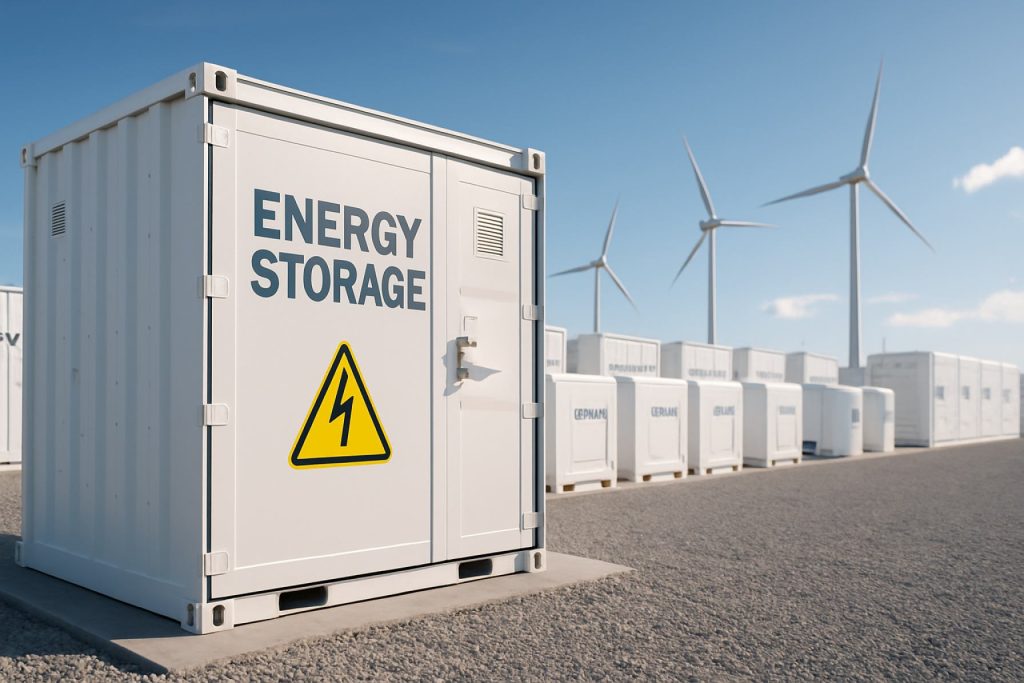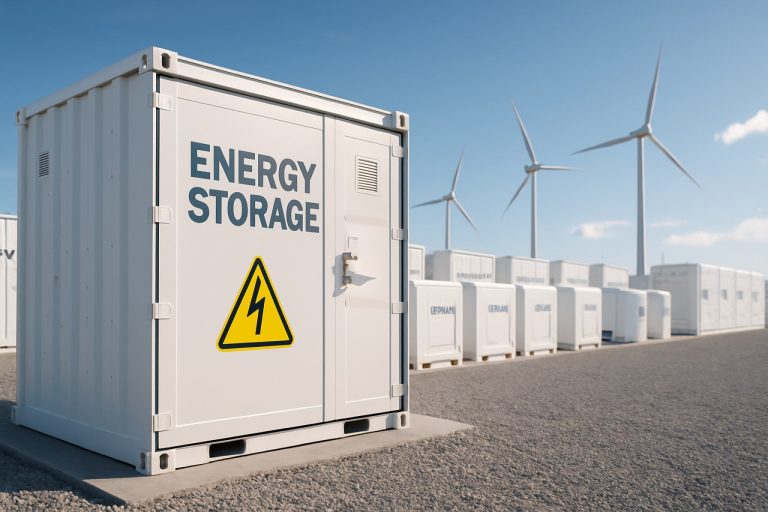
Grid-Scale Energy Storage Systems Market Report 2025: In-Depth Analysis of Growth Drivers, Technology Innovations, and Regional Opportunities for the Next 5 Years
- Executive Summary & Market Overview
- Key Market Drivers and Restraints
- Technology Trends and Innovations in Grid-Scale Energy Storage
- Competitive Landscape and Leading Players
- Market Size, Share, and Growth Forecasts (2025–2030)
- Regional Analysis: North America, Europe, Asia-Pacific, and Rest of World
- Regulatory Environment and Policy Impact
- Challenges, Risks, and Market Entry Barriers
- Opportunities and Strategic Recommendations
- Future Outlook: Emerging Applications and Investment Hotspots
- Sources & References
Executive Summary & Market Overview
Grid-scale energy storage systems (ESS) are large-scale technologies designed to store and dispatch electricity within power grids, playing a pivotal role in enhancing grid reliability, integrating renewable energy, and supporting decarbonization goals. As of 2025, the global market for grid-scale ESS is experiencing robust growth, driven by the accelerating deployment of renewable energy sources, increasing grid modernization initiatives, and supportive policy frameworks.
According to Wood Mackenzie, global grid-scale energy storage installations are projected to surpass 30 GW/90 GWh in 2025, marking a significant increase from previous years. The Asia-Pacific region, led by China, is expected to account for the largest share of new capacity, while the United States and Europe continue to expand their storage portfolios to meet ambitious climate targets and manage grid flexibility challenges.
Lithium-ion batteries remain the dominant technology, accounting for over 85% of new grid-scale deployments due to their declining costs, high efficiency, and scalability. However, alternative technologies such as flow batteries, compressed air energy storage, and pumped hydro are gaining traction for long-duration applications and specific use cases. The market is also witnessing increased investment in hybrid systems that combine storage with solar or wind assets, optimizing both generation and storage economics.
Key market drivers in 2025 include:
- Rising penetration of variable renewable energy sources, necessitating flexible grid resources to balance supply and demand.
- Government incentives and regulatory mandates, such as capacity market reforms and storage targets, particularly in the U.S., EU, and China (International Energy Agency).
- Advancements in battery technology, leading to improved performance, safety, and cost-effectiveness.
- Growing participation of utilities and independent power producers in storage project development (BloombergNEF).
Despite strong momentum, the sector faces challenges including supply chain constraints for critical minerals, evolving regulatory frameworks, and the need for standardized safety protocols. Nevertheless, the outlook for 2025 remains highly positive, with grid-scale ESS positioned as a cornerstone of the global energy transition and a key enabler of resilient, low-carbon power systems.
Key Market Drivers and Restraints
Grid-scale energy storage systems are increasingly recognized as critical enablers of modern electricity grids, particularly as the share of variable renewable energy sources rises. In 2025, several key drivers and restraints are shaping the market trajectory for these systems.
Key Market Drivers
- Renewable Energy Integration: The global push for decarbonization and the rapid deployment of wind and solar power are driving demand for grid-scale storage to balance supply and demand, mitigate intermittency, and provide grid stability. According to the International Energy Agency, energy storage capacity must expand significantly to support renewable integration targets.
- Policy Support and Incentives: Governments worldwide are implementing supportive policies, mandates, and financial incentives to accelerate storage deployment. The U.S. Inflation Reduction Act, for example, includes investment tax credits for standalone storage, while the European Union’s REPowerEU plan prioritizes storage for energy security (U.S. Department of Energy; European Commission Directorate-General for Energy).
- Grid Modernization and Reliability: Aging grid infrastructure and increasing frequency of extreme weather events are prompting utilities to invest in storage for enhanced reliability, peak shaving, and ancillary services (Utility Dive).
- Declining Technology Costs: The cost of lithium-ion batteries and alternative storage technologies continues to fall, making large-scale projects more economically viable. BloombergNEF reports a 14% annual decline in battery pack prices over the past decade (BloombergNEF).
Key Market Restraints
- High Upfront Capital Costs: Despite falling technology prices, grid-scale storage projects require significant initial investment, which can deter utilities and independent power producers, especially in emerging markets (Wood Mackenzie).
- Regulatory and Market Uncertainty: Inconsistent regulatory frameworks, lack of standardized market participation rules, and unclear revenue streams for storage services can hinder project development (International Energy Agency).
- Supply Chain Constraints: Ongoing supply chain disruptions, particularly for critical minerals like lithium, cobalt, and nickel, pose risks to timely project delivery and cost stability (International Energy Agency).
- Technical and Siting Challenges: Integrating large-scale storage into existing grids requires advanced control systems and can face siting, permitting, and community acceptance hurdles (National Renewable Energy Laboratory).
Technology Trends and Innovations in Grid-Scale Energy Storage
Grid-scale energy storage systems are rapidly evolving, driven by the global transition toward renewable energy and the need for grid flexibility. In 2025, several technology trends and innovations are shaping the deployment and performance of these systems, with a focus on enhancing capacity, efficiency, and cost-effectiveness.
Advanced Battery Chemistries: Lithium-ion batteries continue to dominate grid-scale deployments due to their high energy density and declining costs. However, innovations in alternative chemistries—such as sodium-ion, lithium iron phosphate (LFP), and solid-state batteries—are gaining traction. These alternatives offer improved safety, longer lifespans, and reduced reliance on critical minerals, addressing supply chain and sustainability concerns. For instance, Contemporary Amperex Technology Co. Limited (CATL) and LG Energy Solution are investing heavily in next-generation battery technologies for grid applications.
Long-Duration Energy Storage (LDES): The need to store renewable energy for extended periods is driving innovation in long-duration storage solutions. Technologies such as flow batteries (vanadium redox, zinc-bromine), compressed air energy storage (CAES), and gravity-based systems are being piloted and scaled. According to Wood Mackenzie, the global LDES market is expected to grow significantly through 2030, with pilot projects demonstrating up to 100-hour discharge durations.
Hybrid and Integrated Systems: There is a growing trend toward hybrid energy storage systems that combine multiple technologies (e.g., batteries with flywheels or supercapacitors) to optimize performance for specific grid services. These integrated solutions can provide both fast response for frequency regulation and sustained output for load shifting, enhancing grid reliability and resilience. Siemens Energy and GE Vernova are among the leaders developing hybrid storage platforms for utility-scale projects.
- Artificial Intelligence and Digitalization: AI-driven energy management systems are being deployed to optimize storage dispatch, predict maintenance needs, and maximize asset value. Digital twins and advanced analytics are enabling real-time monitoring and predictive control, as highlighted by ABB and Schneider Electric.
- Modular and Scalable Designs: Modular storage units allow for flexible scaling and easier integration into existing grid infrastructure, reducing deployment times and costs.
These technology trends are positioning grid-scale energy storage as a cornerstone of the modern energy system, supporting higher shares of renewables and enabling a more resilient, decarbonized grid in 2025 and beyond.
Competitive Landscape and Leading Players
The competitive landscape of the grid-scale energy storage systems market in 2025 is characterized by rapid technological innovation, strategic partnerships, and aggressive capacity expansions. The sector is dominated by a mix of established energy conglomerates, battery manufacturers, and emerging technology firms, all vying for market share as global demand for renewable integration and grid stability accelerates.
Leading players include Tesla, Inc., whose Megapack lithium-ion battery systems have set industry benchmarks for scalability and deployment speed. Tesla’s global footprint expanded in 2024 with new installations in the U.S., Australia, and Europe, leveraging its vertically integrated supply chain and advanced software for energy management.
Another major contender is LG Energy Solution, which continues to invest in large-scale lithium-ion and next-generation battery chemistries. The company’s partnerships with utilities and renewable developers have resulted in several gigawatt-hours (GWh) of new storage capacity, particularly in Asia-Pacific and North America.
Chinese firms such as Contemporary Amperex Technology Co. Limited (CATL) and Gotion High-Tech are rapidly scaling up production and international projects, leveraging cost advantages and government support. CATL, in particular, has secured contracts for multi-GWh grid storage projects in Europe and the Middle East, while Gotion is expanding its presence in Latin America and Africa.
In the U.S., Fluence Energy remains a key player, offering modular storage solutions and advanced digital platforms for grid optimization. The company’s joint venture origins (Siemens and AES) provide deep expertise in both hardware and software, enabling it to win major utility-scale contracts in 2024 and 2025.
Other notable competitors include NextEra Energy Resources, which integrates storage with its vast renewable portfolio, and Vivint Solar, which is expanding from residential to grid-scale projects. Additionally, European firms like Siemens Energy and ABB are investing in hybrid systems and long-duration storage technologies.
- Market competition is intensifying as new entrants focus on flow batteries, compressed air, and hydrogen-based storage, challenging the dominance of lithium-ion solutions.
- Strategic alliances and mergers are common, as companies seek to secure supply chains and accelerate technology development.
- Regional policy incentives and grid modernization programs are shaping competitive dynamics, with Asia-Pacific and North America leading in project deployments.
Market Size, Share, and Growth Forecasts (2025–2030)
The global grid-scale energy storage systems market is poised for robust expansion in 2025, driven by accelerating renewable energy integration, grid modernization initiatives, and supportive policy frameworks. According to Wood Mackenzie, the global grid-scale energy storage market is expected to add over 30 GW/90 GWh of new capacity in 2025, representing a year-on-year growth rate exceeding 25%. This surge is underpinned by increasing deployments in key markets such as the United States, China, and Europe, where ambitious decarbonization targets and grid reliability concerns are catalyzing investments.
In terms of market value, MarketsandMarkets projects the grid-scale energy storage market to reach approximately USD 10.5 billion in 2025, up from an estimated USD 7.5 billion in 2023. Lithium-ion battery technology continues to dominate, accounting for over 80% of new installations, though alternative chemistries such as flow batteries and sodium-based systems are gaining traction, particularly for long-duration storage applications.
Regionally, the United States is anticipated to maintain its leadership, with the Energy Information Administration (U.S. Energy Information Administration) forecasting over 10 GW of new grid-scale battery storage capacity to be operational by the end of 2025. China is also set for significant growth, supported by the government’s 14th Five-Year Plan, which targets over 30 GW of cumulative energy storage capacity by 2025. The European Union, propelled by the REPowerEU plan and national energy transition strategies, is expected to contribute over 6 GW of new grid-scale storage installations in 2025.
- Market Share: The top five players—Tesla, LG Energy Solution, Siemens Energy, Siemens Gamesa, and CATL—collectively account for over 60% of global grid-scale storage deployments in 2025.
- Growth Drivers: Key factors include falling battery costs, enhanced grid flexibility requirements, and regulatory mandates for renewable integration and emissions reduction.
- Growth Forecast (2025–2030): Industry analysts, including BloombergNEF, forecast a compound annual growth rate (CAGR) of 23–27% for grid-scale energy storage systems through 2030, with global installed capacity projected to surpass 500 GWh by the end of the decade.
Regional Analysis: North America, Europe, Asia-Pacific, and Rest of World
The grid-scale energy storage systems market is experiencing robust growth across all major regions—North America, Europe, Asia-Pacific, and the Rest of the World—driven by the accelerating integration of renewable energy, grid modernization efforts, and supportive policy frameworks.
- North America: The United States leads the North American market, propelled by aggressive renewable energy targets and federal incentives. The U.S. Department of Energy’s Energy Storage Grand Challenge and state-level mandates, such as California’s energy storage procurement targets, are catalyzing large-scale deployments. By 2025, North America is expected to account for a significant share of new grid-scale storage capacity, with lithium-ion batteries dominating installations, but with growing interest in long-duration technologies such as flow batteries and compressed air energy storage (U.S. Department of Energy).
- Europe: Europe’s market is shaped by the European Union’s Green Deal and the Fit for 55 package, which emphasize decarbonization and grid flexibility. Countries like Germany, the UK, and Spain are at the forefront, leveraging both national subsidies and EU funding to accelerate storage projects. The region is also witnessing increased deployment of hybrid renewable-plus-storage plants and a focus on grid balancing services, with the European Commission projecting a doubling of installed storage capacity by 2025 (European Commission).
- Asia-Pacific: Asia-Pacific is the fastest-growing region, led by China, Japan, South Korea, and Australia. China’s 14th Five-Year Plan mandates significant grid-scale storage additions to support its ambitious renewable energy targets. South Korea’s government-backed incentives and Australia’s rapid solar and wind adoption are also driving storage investments. The region is characterized by a mix of technologies, including advanced batteries, pumped hydro, and emerging hydrogen storage solutions (International Energy Agency).
- Rest of World: In Latin America, the Middle East, and Africa, grid-scale storage is gaining traction, albeit from a smaller base. Latin American countries like Chile and Brazil are integrating storage to stabilize grids with high solar and wind penetration. In the Middle East, the UAE and Saudi Arabia are piloting storage projects to complement large-scale renewables, while Africa is exploring storage to enhance rural electrification and grid reliability (International Renewable Energy Agency).
Overall, regional dynamics in 2025 reflect a convergence of policy support, technology innovation, and market demand, positioning grid-scale energy storage as a critical enabler of the global energy transition.
Regulatory Environment and Policy Impact
The regulatory environment for grid-scale energy storage systems (ESS) in 2025 is characterized by rapid evolution, as policymakers and regulators worldwide recognize the critical role of storage in supporting renewable integration, grid reliability, and decarbonization goals. In major markets such as the United States, the Federal Energy Regulatory Commission (FERC) has continued to implement and refine policies like Order 841, which mandates that regional transmission organizations (RTOs) and independent system operators (ISOs) allow energy storage resources to participate in wholesale energy, capacity, and ancillary services markets on a level playing field with other resources. This has led to increased market access and revenue opportunities for storage developers and operators Federal Energy Regulatory Commission.
At the state level, progressive policies in California, New York, and Texas have set ambitious storage procurement targets and provided incentives for deployment. For example, California’s Assembly Bill 2514 and subsequent regulatory actions have established one of the world’s largest storage mandates, driving significant investment and innovation California Public Utilities Commission. New York’s Climate Leadership and Community Protection Act (CLCPA) similarly targets 6 GW of storage by 2030, with supportive funding and streamlined permitting processes New York State Energy Research and Development Authority.
In the European Union, the Clean Energy for All Europeans package and the revision of the Electricity Directive have clarified the role of storage as a distinct asset class, removing barriers to ownership and operation by both grid operators and third parties. The EU’s “Fit for 55” package and the REPowerEU plan further incentivize storage deployment to meet aggressive renewable energy targets and reduce reliance on fossil fuels European Commission Directorate-General for Energy.
However, regulatory uncertainty remains a challenge in some regions, particularly regarding market design, revenue stacking, and the treatment of storage as both generation and load. Issues such as double-charging of grid fees and lack of standardized interconnection procedures can hinder project economics. Policymakers are increasingly addressing these barriers through targeted reforms, pilot programs, and stakeholder engagement.
Overall, the 2025 policy landscape is increasingly favorable for grid-scale ESS, with clear signals from governments and regulators that storage is essential for a flexible, resilient, and low-carbon power system. Ongoing regulatory innovation and harmonization will be crucial to unlocking the full market potential of grid-scale energy storage worldwide.
Challenges, Risks, and Market Entry Barriers
Grid-scale energy storage systems (ESS) are pivotal for the transition to renewable energy and grid modernization, but their deployment faces significant challenges, risks, and market entry barriers in 2025. One of the primary challenges is the high upfront capital expenditure required for large-scale installations. Advanced battery chemistries, such as lithium-ion and flow batteries, remain expensive due to raw material costs and supply chain constraints, particularly for critical minerals like lithium, cobalt, and vanadium. This cost barrier is exacerbated by global competition for these resources, leading to price volatility and supply insecurity International Energy Agency.
Regulatory uncertainty is another major obstacle. Many regions lack clear frameworks for integrating ESS into electricity markets, resulting in unclear revenue streams and limited incentives for investment. Inconsistent policies regarding grid interconnection, safety standards, and market participation further complicate project development. For example, in the United States, regulatory fragmentation across states creates a patchwork of rules that can delay or deter market entry U.S. Department of Energy.
Technical risks also persist. Grid-scale ESS must demonstrate long-term reliability, safety, and performance under diverse operating conditions. Battery degradation, thermal runaway, and fire hazards are ongoing concerns, especially as systems scale up in size and complexity. Additionally, integrating ESS with existing grid infrastructure requires advanced control systems and interoperability standards, which are still evolving National Renewable Energy Laboratory.
Market entry barriers are heightened by the dominance of established players with proprietary technologies and strong relationships with utilities and grid operators. New entrants face steep learning curves, high R&D costs, and the need to secure bankable project financing. Furthermore, the long project development cycles and uncertain return on investment can deter private capital, particularly in emerging markets where grid modernization is most needed Wood Mackenzie.
In summary, while the outlook for grid-scale energy storage is robust, overcoming these challenges in 2025 will require coordinated policy support, technological innovation, and new business models to reduce costs, mitigate risks, and streamline market access.
Opportunities and Strategic Recommendations
The grid-scale energy storage systems market in 2025 is poised for significant expansion, driven by the accelerating integration of renewable energy sources, grid modernization initiatives, and supportive policy frameworks. As utilities and grid operators seek to address the intermittency of renewables and enhance grid reliability, several key opportunities and strategic recommendations emerge for stakeholders.
- Expansion of Renewable Integration: The increasing penetration of solar and wind power is creating a robust demand for large-scale storage solutions to balance supply and demand. Companies should focus on developing and deploying advanced battery technologies, such as lithium-ion and flow batteries, that offer high efficiency and scalability. According to the International Energy Agency, global grid-scale battery storage capacity is expected to triple by 2025, underscoring the urgency for innovation and capacity expansion.
- Grid Services and Ancillary Markets: Grid-scale storage systems are increasingly being utilized for frequency regulation, voltage support, and peak shaving. Market participants can capitalize on emerging ancillary service markets by offering flexible, fast-response storage solutions. The U.S. Department of Energy highlights that storage systems providing multiple grid services can unlock new revenue streams and improve project economics.
- Policy and Regulatory Alignment: Strategic engagement with policymakers is essential to shape favorable regulatory environments. Stakeholders should advocate for clear market rules, streamlined permitting, and incentives that recognize the full value stack of storage. The Energy Storage News platform reports that regions with supportive policies, such as the U.S. and parts of Europe, are witnessing accelerated project deployments.
- Hybrid and Co-located Projects: Integrating storage with renewable generation assets (e.g., solar-plus-storage) can optimize asset utilization and reduce costs. Developers should explore hybrid project models and partnerships with renewable energy providers to enhance competitiveness and secure long-term power purchase agreements.
- Geographic Diversification: Emerging markets in Asia-Pacific, Latin America, and the Middle East present untapped potential for grid-scale storage, driven by rapid urbanization and grid expansion. Companies should assess local market dynamics, grid needs, and regulatory landscapes to tailor their entry strategies.
In summary, the grid-scale energy storage sector in 2025 offers substantial growth opportunities for technology providers, utilities, and investors. Strategic focus on innovation, market participation, policy advocacy, and geographic expansion will be critical to capturing value in this evolving landscape.
Future Outlook: Emerging Applications and Investment Hotspots
Looking ahead to 2025, the future outlook for grid-scale energy storage systems is shaped by accelerating renewable energy integration, grid modernization initiatives, and evolving regulatory frameworks. As global electricity demand rises and decarbonization targets become more ambitious, grid-scale storage is increasingly recognized as a critical enabler for reliable, flexible, and resilient power systems.
Emerging applications are expanding beyond traditional load shifting and frequency regulation. In 2025, advanced storage solutions are expected to play a pivotal role in:
- Renewable Integration: With solar and wind generation projected to account for a larger share of the energy mix, storage systems will be essential for smoothing output variability and providing firm capacity. Hybrid projects combining renewables with storage are gaining traction, particularly in markets with high renewable penetration such as the U.S., Europe, and China (International Energy Agency).
- Grid Resilience and Black Start Capabilities: As extreme weather events and cyber threats increase, utilities are investing in storage to enhance grid resilience and provide black start services, enabling faster recovery from outages (Utility Dive).
- Transmission and Distribution (T&D) Deferral: Storage is being deployed to defer costly upgrades to T&D infrastructure, especially in congested urban areas and remote regions. This application is attracting interest from utilities and regulators seeking cost-effective grid solutions (Wood Mackenzie).
- Ancillary Services and Market Participation: Storage systems are increasingly participating in wholesale electricity markets, providing fast-response ancillary services such as frequency regulation, voltage support, and spinning reserve (Federal Energy Regulatory Commission).
Investment hotspots in 2025 are expected to include North America, driven by the Inflation Reduction Act and state-level mandates; Europe, where grid stability and energy security are priorities; and Asia-Pacific, particularly China and Australia, which are scaling up storage to support aggressive renewable targets (BloombergNEF). Lithium-ion technology will continue to dominate, but alternative chemistries such as sodium-ion, flow batteries, and long-duration storage solutions are attracting significant venture capital and pilot project funding (IDTechEx).
Overall, 2025 will mark a pivotal year for grid-scale energy storage, with new business models, policy support, and technology breakthroughs driving both market expansion and diversification of applications.
Sources & References
- Wood Mackenzie
- International Energy Agency
- European Commission Directorate-General for Energy
- Utility Dive
- BloombergNEF
- National Renewable Energy Laboratory
- Contemporary Amperex Technology Co. Limited (CATL)
- Siemens Energy
- GE Vernova
- Gotion High-Tech
- Fluence Energy
- MarketsandMarkets
- BloombergNEF
- California Public Utilities Commission
- Energy Storage News
- IDTechEx



